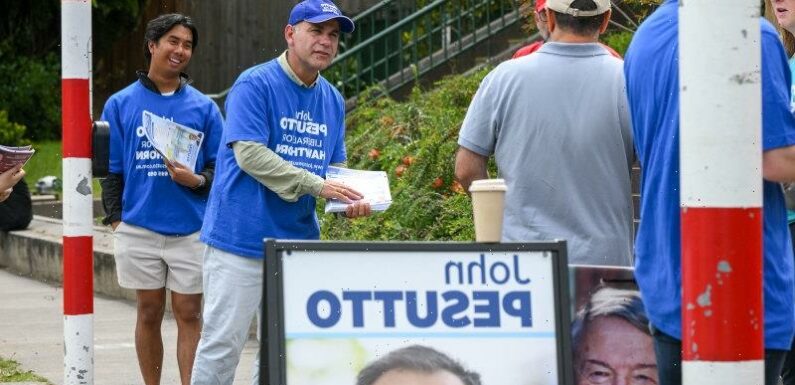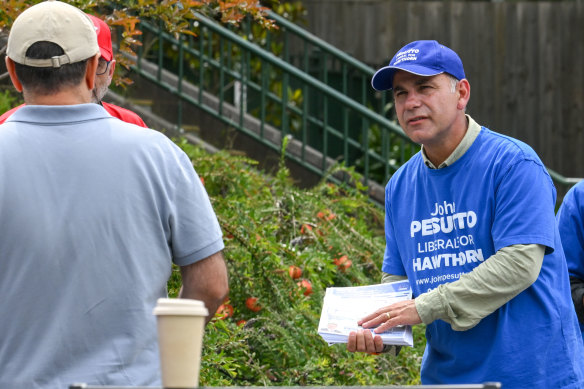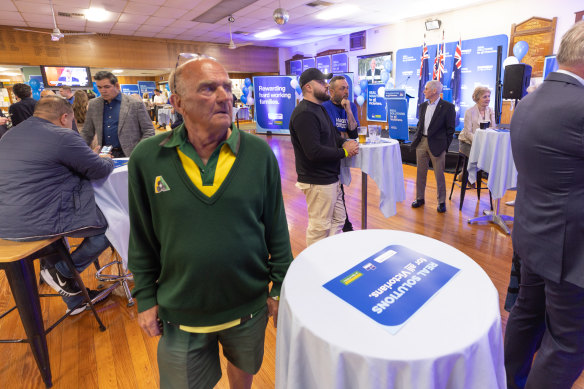
The Victorian Liberal Party has vowed to put home ownership for younger people “front and centre” of its policies to try to avoid a looming demographic cliff as tens of thousands of its voters die before the next election.
The Liberal Party won less than 30 per cent of the primary vote at November’s state election, and the Nationals 4.8 per cent. Demographic analysis by polling firm RedBridge shows that by the 2026 state election an additional 60,000 to 70,000 of the Coalition’s voting base will have died and the two parties’ combined vote would likely drop below 30 per cent.
John Pesutto canvassing for votes on election day.Credit:Eddie Jim
Australian National University political science professor Ian McAllister said unlike previous generations Millennials were not becoming more conservative as they aged, partly because of a lack of economic prosperity and partly because of social media.
New opposition leader John Pesutto told The Age his party would work to appeal to younger people particularly by promoting home ownership, as well as rebuilding the energy grid to deliver renewables to where power is needed and boosting women’s representation in the Liberal Party.
“We must do better with younger demographics, not just women but also younger males as well,” Pesutto said. “Definitely that’s something we are going to focus on intensely.”
RedBridge director Kos Samaras, a respected pollster and former Labor Party campaigner, said Baby Boomers, born between 1946 and 1964, and the silent generation, born between 1928 and 1945, made up three-quarters of the Coalition voter base.
Scenes of dejection at the Liberal Party gathering on election night, November 26.Credit:Jason South
They would make up just one-third of all voters by the time of the next election in 2026, with Millennials and Generation Z becoming more influential.
Samaras said younger voters were no longer economically or culturally connecting with the conservative parties.
“The Liberals will say we need to find a way to connect to [younger voters] but that is like trying to say, how do we get Welsh miners to vote for Margaret Thatcher?
”Purely on demographics, they (the Coalition) could end up the same number of primary votes as this election, but obviously the voters’ roll will be much larger, with close to 400,000 additional votes.“
Pesutto acknowledged that turning back the demographic tide was a “complex and deep” problem, although he insisted it was achievable. Among other things, he said it would require the Coalition to convince economically disillusioned younger voters that home ownership was an attainable goal with the right policy settings.
“It is precisely because people are losing so much hope that it is so important to address this and put it front and centre of what we want to do,” he said.
“What we are saying is, don’t lose hope, we will work with you and with everyone to try to find those solutions to give you that option.”
Pesutto said all options would be considered, with a particular focus on boosting the supply of houses. But he also did not shy away from the possibility of adopting a plan being put into place by the NSW Perrottet government under which stamp duty is being replaced with an ongoing broad-based annual land tax on an “opt-in” basis.
“For the purposes of looking at what is possible all things should be on the table,” he said. “I’m very comfortable with that body of work looking at different options, and NSW is doing that and we’ll have a look at what they have done.”
The ANU’s McAllister, who co-directs the Australian Election Study after each federal election agreed that, “Younger people are defecting from the Coalition and are simply not voting for them”.
He said only about one in five people aged under 25 nationally were voting for the Coalition and only about one in four Millennials, who are aged between 25 and about 40.
“Very shortly, probably in the next three, four years or so, Millennials and Generation Z will form a majority of the population,” McAllister said, but people aged in their late 20s and 30s were one of the least satisfied-with-democracy groups that we’ve ever polled.
“We drill into that and a lot of it is that they find difficulty getting on the housing ladder, and that leads them to be distrustful and dissatisfied with politics.”
Younger generations are also more likely to rate the environment as a key concern, which is seen as an area of weakness for the Coalition, compounding its demographic problems.
Pesutto said he believed the Coalition’s election campaign announcements on the environment had been well received, including beefed-up emission reduction targets and subsidies for household solar and batteries. But over the next four years the government would confront the difficult challenge of reforming the electricity grid for the inevitable exit of coal-fired power generators.
Pesutto suggested the Andrews government could be heading for trouble in regional areas, with thousands of kilometres of new transmission lines needed to support the rapid uptake of renewable energy.
“We are going into a more difficult phase where the rubber is starting to hit the road. We are now starting to have to make serious decisions about what transmission infrastructure is going to run through what communities,” he said.
Pesutto said the Liberal Party also needed to boost the representation of women, suggesting it was a tricky issue because of the party’s demographics.
“I’m quite keen on something more than targets,” he said. “It may well be that the administrative side of the party can look at [saying] … ‘we are really only going to look at female candidates (in certain seats)’.”
The Morning Edition newsletter is our guide to the day’s most important and interesting stories, analysis and insights. Sign up here.
Most Viewed in Politics
From our partners
Source: Read Full Article

